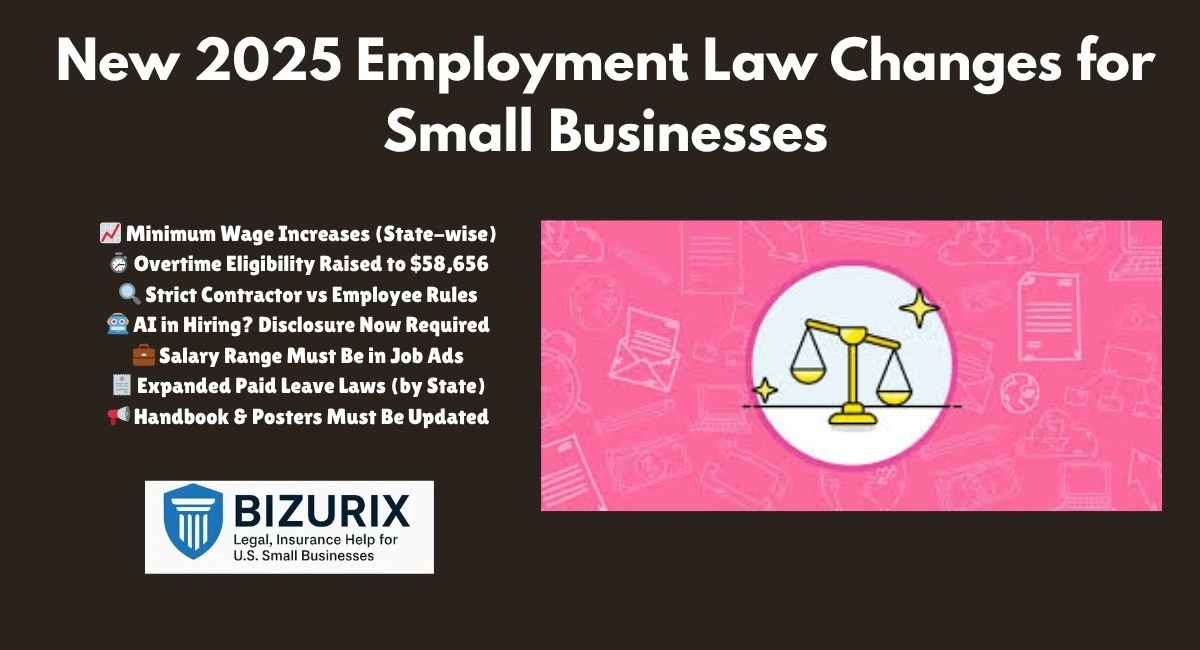New 2025 Employment Law Changes for Small Businesses

New 2025 employment law changes for small businesses are reshaping how companies operate across the United States. These updates affect how you hire, pay, and manage your team. Whether you run a local shop or a remote business, keeping up with new rules isn’t optional; it’s how you stay protected and trusted by your employees.
New 2025 Employment Law Changes for Small Businesses: Why These Updates Matter
Small business owners are often focused on customers, inventory, and keeping the lights on. While small business owners may not prioritize legal compliance, it is crucial to do so. In 2025, multiple states and the federal government rolled out new laws that directly affect
- Wages and employee rights
- Overtime rules and pay
- Worker classification (employee vs contractor)
- Hiring practices and use of automation
- Salary transparency in job listings
- Leave policies and employee handbooks
These aren’t minor adjustments. One mistake—like misclassifying an employee or failing to include salary info—can lead to serious penalties, lawsuits, or lost talent.
Key Workplace Law Updates in 2025 Small Business Owners Must Know
a) Higher Minimum Wages
Many states raised their minimum wages. Here are just a few examples:
- California: $16.00/hour
- Washington: $16.28/hour
- New York (NYC): $16.50/hour
As a business owner, you must pay the higher of the state or federal minimum wage. That means checking your local requirements, not just national ones.
b) New Overtime Threshold
The federal salary threshold for overtime eligibility has increased. Employees earning less than $58,656 per year will have to pay time-and-a-half for overtime starting in 2025. That affects many roles once considered exempt.
To stay compliant:
- Reevaluate employee classifications
- Adjust payroll systems to reflect new rates
- Communicate changes to your team clearly
c) Worker Classification Rules Tightened
The Department of Labor has narrowed the definition of “independent contractor.” If you control how, when, and where work is done—and the person relies on your business for income—they’re likely an employee.
Why this matters:
- Misclassifying workers leads to back taxes and legal fines
- It can cost you health benefits, insurance claims, and unemployment tax liabilities
We must carefully evaluate even gig-style or remote roles.
d) AI in Hiring Must Be Disclosed
Should we use automated resume screening tools or chat-based interview bots? In 2025, these must be disclosed to job applicants in some states. You must explain:
- What tech is used
- How it affects decision-making
- Whether humans review results
It’s about fairness and bias prevention. Also, retain all hiring records for at least 12 months.
e) Updated Leave Policies
Paid leave is expanding in many states. Some examples:
- Colorado: 12 weeks of paid family leave
- Oregon: Mandated medical and caregiving leave
- New Jersey: Expanded temporary disability leave
Small business owners must include these in handbooks, clearly explaining who’s eligible and how to apply.
f) Pay Transparency Laws
Posting salary ranges in job listings is now required in several states. For example:
- California and New York: Must list pay ranges in all job ads
- Colorado: Must notify employees of internal promotions
- Washington: Must disclose benefits along with pay
This applies even to remote jobs if they’re open to applicants in those states.
How to Make Sure You’re Following the New Rules
- Classify workers properly—use IRS and DOL tests
- Update job ads—include clear salary ranges
- Train your hiring managers on AI use and disclosures
- Audit your payroll system for compliance with overtime thresholds
- Refresh your employee handbook with all state-specific leave and pay rules
- Post updated labor law posters in visible office locations or send digitally to remote teams
What’s New in 2025 Compared to Previous Years?
This year’s updates reflect deeper shifts in how work is done:
- More remote jobs = more complexity across states
- Salary equity is becoming legally required, not optional
- AI hiring tools are no longer unregulated—they’re being watched
- Workers expect transparency, not just compliance
For small businesses, this means you must think like big companies when it comes to HR policies.
Real Scenarios from U.S. Small Businesses
Case 1: Misclassified Worker in Ohio
A bakery hired delivery drivers as contractors. The state audited them and fined them $8,000 for unpaid unemployment insurance.
Case 2: Salary Range Violation in California
A marketing firm posted “competitive pay” but no numbers. A job applicant reported the marketing firm, which resulted in a $2,000 fine and the requirement to repost the job.
Case 3: Missing Leave Policy in Oregon
The company denied medical leave to an employee. After filing a complaint, the business had to reinstate them and pay a penalty.
FAQs About New 2025 Employment Law Changes for Small Businesses
1) Who needs to follow these laws?
Any U.S. business with employees, even part-time or remote, must follow federal and state rules.
2) What’s the overtime rule in 2025?
Under $58,656/year, employees must receive overtime compensation for additional hours worked.
3) Should we post salary ranges everywhere?
Only in certain states—but if you’re hiring remotely, it’s safest to include them always.
4) Can I still hire contractors?
Certainly, but please ensure that you are not treating them as employees. Please ensure you utilize a contract and adhere to IRS guidelines.
5) What should I add to my employee handbook?
I should include new leave policies, salary transparency policies, and regulations on discrimination and AI use in my employee handbook.
6) What happens if I don’t comply?
The consequences could include fines, lawsuits, employee claims, or audits. Plus, your reputation could take a hit.